Yesterday, Americans celebrated Groundhog’s Day, an odd, but perhaps also endearing tradition to welcome the coming of spring. Although Punxsutawney Phil may be unique, traditions that say good-bye to winter and welcome spring are not. From Poland’s drowning of the Marzanna (a straw doll) to throwing colored powder at each other in India’s Holi, the celebration of spring after a long winter is important in cultures across the globe.
The Balkans has its fair share of spring traditions as well. Many of them share characteristics of their neighbors, no doubt from centuries of cross-cultural contact. From giant vats to scrambled eggs to red and white woven bracelets tied to trees, the coming of spring is a time for celebration across the Balkans.

Cimburijada (Bosnia)
In the city of Zenica, Bosnia, the townspeople celebrate the coming of spring with a giant breakfast: Cimburijada is literally the Festival of Scrambled Eggs. At the crack of dawn on March 21st (the first day of spring), everyone heads down to the Kamberovića field, next to the Bosna River, to celebrate together. Many even pitch tents there the night before so they don’t miss the sunrise. Although some people jump in the river, the biggest part of this day (literally) is the breakfast, a ginormous pot of cimbur, or scrambled eggs, for the town. Eating breakfast with friends and family is the traditional way of celebrating the coming of spring every year.
Marti (Greece)
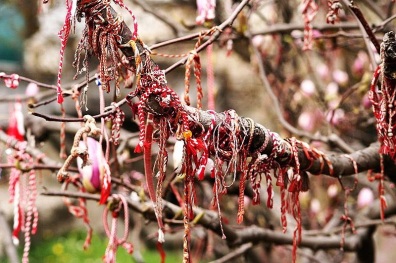
In Greece, there is the tradition of the Marti (μάρτης). The marti is a bracelet made of red and white thread. Although the tradition is especially for children, adults follow it too, although it is especially popular in rural areas of Greece today. Mothers often make the bracelets for their children, but they are supposed to be given as gifts too. Greeks put the bracelet on starting on the first of March, and don’t take it off until the month is over. The bracelets were supposed to protect children’s cheeks against the rays of the sun, which were supposed to be especially strong in March. One theory about the colors is that they symbolize a rosy cheeks and a white complexion. To provide double protection, the evil eye is frequently being added to these bracelets nowadays too.
The tradition supposedly has its origins in the Eleusinian Mysteries of Ancient Greece, where the participants wore a threaded bracelet around their right hand and left foot. The tradition varies a bit by region in Greece. In some areas, the bracelet is put on rose bushes for swallows to pick up and build their nests; in others, the bracelet is tied around pitchers to keep them cold or trees to make them bear fruit.
Baba Marta (Bulgaria)
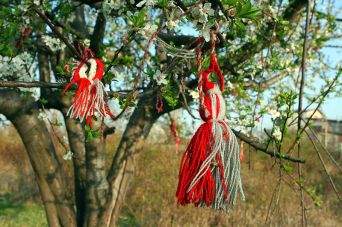
Bulgarians celebrate Baba Marta Day on March 1st. Baba Marta (Баба Марта | Grandma Marta) is a mythical cranky old witch who, if not treated kindly, will make the cold and bleak winter last longer. But seeing red fabric apparently made Baba Marta laugh, and her laughter made the sun shine again. She is supposedly a very mercurial individual, symbolizing the fickleness of weather during the early stages of spring.
To celebrate the day, Bulgarians pass out and wear Martenitsa, woolen adornments that are the same red and white colors as the Greek Marti. In Bulgaria, the white symbolizes beauty and purity, while the red symbolizes health, fertility, and love – and they don’t protect against sunburnt cheeks. They can be worn pinned to clothes or as bracelets, and the bracelets often have things woven into them, such as beads, horse hair, and iron rings. Small woolen dolls are a common version. Once they have seen the first stork of spring, Bulgarians must take the martenitsa off and put it on a blooming tree. According to some stories, the tradition goes back to the time of Khan Asparukh, a Bulgar khan from the 7th century.
Martisor (Romania)
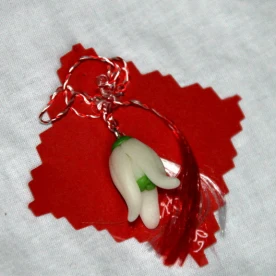
Romania also has a spring tradition of the red and white trinkets, termed martisoare (martisor is singular). They can be simple bracelets or more complex versions with jewelry, lace, or even flowers inserted in between the threads. Between March 1st and 8th, men will give the important women in their lives, from spouses to business partners, martisoare to show their respect and admiration. In some parts of Romania, men will also receive martisoare. Supposedly the red represents the summer and the white represents the winter, and the tradition potentially even goes back to Roman times. On March 8th, the Romanian women take off the martisoare and tie them to the branches of fruit trees, just like in Bulgaria and in certain parts of Greece. But in Romania it is not all sad – March 8th is Women’s Day, so after the celebration of the martisoare, they now have something else to celebrate too.
Hıdırellez (Turkey)
In Turkey, along with most Turkic countries, they celebrate the spring festival of Hıdırellez on May 5th and 6th. Although its origins are from the steppes of Central Asia, the holiday has taken a religious tone through associations with the prophets al-Khidr (Hızır) and Elijah (İlyas), who supposedly met each other on this date thousands of years ago. Both prophets were associated with important themes for spring: rebirth and rain respectively. Over time, their names were combined and it became the festival of Hıdırellez.
The celebrations typically occur in green places, near water, or near tombs or shrines. One part of the celebration is jumping over the purifying fire, which will cure illness and prevent jealousy. The belief that Hızır, in addition to rebirth, also brings blessings. People make small models of what they want, perhaps a house or a garden, and they hope that Hızır will provide them with the real thing.
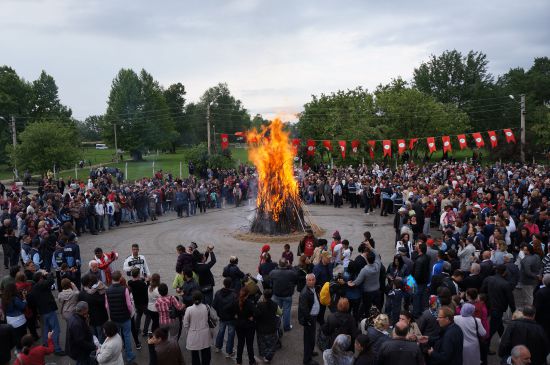
Celebrations in Istanbul usually take the form of a parade from downtown Sultanahmet Square to Ahırkapı Square, a Roma neighborhood. Performances and lively music naturally accompany the parade and the festivities. Today, Hıdırellez is more frequently observed in the villages and towns than in the larger metropolises.
Đurđevdan (Serbia)
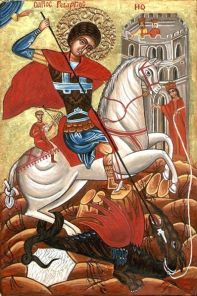
Serbs, like other Orthodox Christians, consider St. George (the dragon-slayer) one of the most important saints. They celebrate St. George’s Day, known as Đurđevdan, on May 6th (technically April 23rd, but they go by the Julian Calendar rather than our Gregorian Calendar for calculating saints days), but in Serbia it gains a special significance as a spring festival. It is also celebrated by other peoples from the former Yugoslavia, and the holiday’s spring connotation likely has a link to the Turkish Hıdırellez, celebrated around the same time and no doubt celebrated while Serbia was under Ottoman occupation.
Dita e Verës (Albania)
Albanians celebrate Spring Day, known as Dita e Verës, on March 14 every year – since 2004 it is an official Albanian holiday. It is widely celebrated in Albania and even in the Albanian diaspora. Youth wear a verore, a red and white bracelet similar to those used in Greece, Bulgaria, and Romania for their spring celebrations. Like in those countries, Albanians take the bands off at the end of the day and hang it on a tree, both believing it will bring good luck and that birds will use them to make their nests.
It is also a time of rejuvenation. The oldest woman of the family puts grass under the pillows of the family’s children the night before to symbolize rejuvenation. Other family members have duties too, such as leaving the door open to symbolize generosity and fertilizing the olive trees. Traditionally there was a crossing of the fire as well, to symbolize crossing from winter into spring, similar to the Turkish tradition in Hıdırellez, but this has become less common. Although possibly influenced by surrounding springtime traditions, Albanians link Dita e Verës back to ancient pagan rituals of their ancestors.
Leave a comment